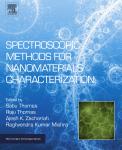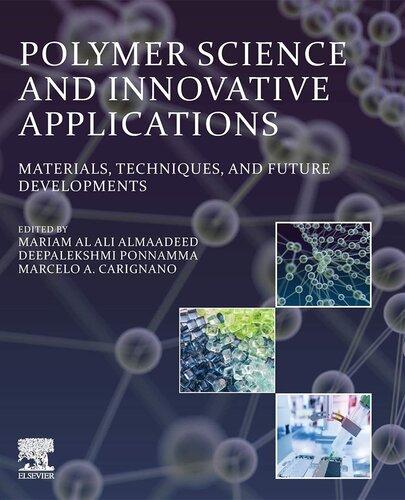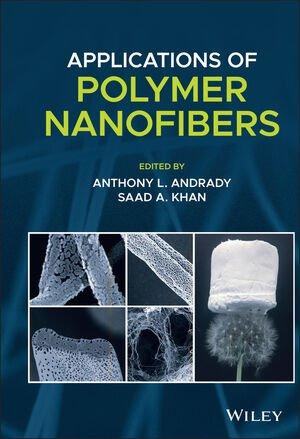Spectroscopic Techniques for Polymer Characterization: Methods, Instrumentation, Applications Yukihiro
Ozaki
Visit to download the full and correct content document: https://ebookmass.com/product/spectroscopic-techniques-for-polymer-characterizatio n-methods-instrumentation-applications-yukihiro-ozaki/

products digital (pdf, epub, mobi) instant download maybe you interests ...

Polymer Electrolytes: Characterization and Applications
Arof https://ebookmass.com/product/polymer-electrolytescharacterization-and-applications-arof/

Spectroscopic Methods for Nanomaterials
Characterization. A volume in Micro and Nano Technologies 1st Edition Edition Sabu Thomas
https://ebookmass.com/product/spectroscopic-methods-fornanomaterials-characterization-a-volume-in-micro-and-nanotechnologies-1st-edition-edition-sabu-thomas/

Nanomaterial and Polymer Membranes. Synthesis, Characterization, and Applications 1st Edition Tawfik Abdo Saleh
https://ebookmass.com/product/nanomaterial-and-polymer-membranessynthesis-characterization-and-applications-1st-edition-tawfikabdo-saleh/

Polymer science and innovative applications materials, techniques, and future developments Deepalekshmi Ponnamma
https://ebookmass.com/product/polymer-science-and-innovativeapplications-materials-techniques-and-future-developmentsdeepalekshmi-ponnamma/

Characterization Techniques for Perovskite Solar Cell Materials Meysam Pazoki
https://ebookmass.com/product/characterization-techniques-forperovskite-solar-cell-materials-meysam-pazoki/

Experimental methods and instrumentation for chemical engineers Second Edition Patience
https://ebookmass.com/product/experimental-methods-andinstrumentation-for-chemical-engineers-second-edition-patience/

Applications
of
Polymer Nanofibers Anthony L. Andrady
https://ebookmass.com/product/applications-of-polymer-nanofibersanthony-l-andrady/

Reinforced polymer composites processing, characterization and post life cycle assessment WileyVch
https://ebookmass.com/product/reinforced-polymer-compositesprocessing-characterization-and-post-life-cycle-assessment-wileyvch/

Advanced nanomaterials for catalysis and energy: synthesis, characterization and applications Sadykov
https://ebookmass.com/product/advanced-nanomaterials-forcatalysis-and-energy-synthesis-characterization-and-applicationssadykov/

SpectroscopicTechniquesforPolymerCharacterization
SpectroscopicTechniquesforPolymer Characterization
Methods,Instrumentation,Applications
EditedbyYukihiroOzakiandHarumiSato
Editors
ProfessorYukihiroOzaki KwanseiGakuinUniversity SchoolofBiologicaland EnvironmentalSciences 2-1Gakuen,Sanda 669-1337Sanda,Hyogo Japan
ProfessorHarumiSato KobeUniversity GraduateSchoolofHuman DevelopmentandEnvironment 3-11Tsurukabuto,Nada-ku 657-8501Hyogo,Kobe Japan
CoverImage: ©HarumiSato
Allbookspublishedby WILEY-VCH arecarefully produced.Nevertheless,authors,editors,and publisherdonotwarranttheinformation containedinthesebooks,includingthisbook, tobefreeoferrors.Readersareadvisedtokeep inmindthatstatements,data,illustrations, proceduraldetailsorotheritemsmay inadvertentlybeinaccurate.
LibraryofCongressCardNo.: appliedfor
BritishLibraryCataloguing-in-PublicationData Acataloguerecordforthisbookisavailable fromtheBritishLibrary.
Bibliographicinformationpublishedby theDeutscheNationalbibliothek TheDeutscheNationalbibliotheklists thispublicationintheDeutsche Nationalbibliografie;detailedbibliographic dataareavailableontheInternetat <http://dnb.d-nb.de>.
©2022WILEY-VCHGmbH,Boschstr. 12,69469Weinheim,Germany
Allrightsreserved(includingthoseof translationintootherlanguages).Nopartof thisbookmaybereproducedinanyform–by photoprinting,microfilm,oranyother means–nortransmittedortranslatedintoa machinelanguagewithoutwrittenpermission fromthepublishers.Registerednames, trademarks,etc.usedinthisbook,evenwhen notspecificallymarkedassuch,arenottobe consideredunprotectedbylaw.
PrintISBN: 978-3-527-34833-6
ePDFISBN: 978-3-527-83030-5
ePubISBN: 978-3-527-83032-9
oBookISBN: 978-3-527-83031-2
Typesetting Straive,Chennai,India
Printedonacid-freepaper
10987654321
Contents
ListofContributors xiii
Preface xvii
GeneralIntroduction xix
PartIRecentProgressonSpectroscopicTechniques 1
1PolymerSpectroscopy–SpectroscopyfromtheFar-Ultraviolet toFar-Infrared/TerahertzandRamanSpectroscopy 3 YukihiroOzakiandHarumiSato
1.1IntroductiontoPolymerSpectroscopy 3
1.1.1OutlineofPolymerSpectroscopy 3
1.1.2BriefHistoryofPolymerSpectroscopy 5
1.2OverviewofMolecularSpectroscopyfromtheFar-Ultravioletto Far-Infrared/TerahertzandRamanSpectroscopyinPolymer Research 6
1.2.1IRandRamanSpectroscopyAnalyses 6
1.2.2FIR/TerahertzandLow-FrequencyRamanSpectroscopy 8
1.2.3Near-Infrared(NIR)Spectroscopy 8
1.2.4SERSandTERSSpectroscopy 9
1.2.5FUVSpectroscopy 9
1.3SpecificExamplesofMolecularSpectroscopyStudiesofPolymers 10
1.3.1Infrared,Raman,andNIRSpectroscopicEvidencefortheCoexistenceof HydrogenBondTypesinPoly(AcrylicAcid) 10
1.3.2Low-FrequencyVibrationalModesofNylon-6StudiedbyUsingIRand RamanSpectroscopiesandDensityFunctionalTheoryCalculations 16
1.3.3NIRSpectraofLinearLow-DensityPolyethyleneandTheir ChemometricsAnalysis 21
1.3.4StudyoftheCrystallizationBehaviorofAsymmetricPLLA/PDLABlend byIRandRamanSpectroscopyandRamanImaging 23
1.3.53DSERSImagingUsingChemicallySynthesizedHighlySymmetric NanoporousSilverMicroparticles 28
1.3.6Tip-EnhancedRamanScatteringSpectroscopyStudyofLocal InteractionsattheInterfaceofStyrene–ButadieneRubber/Multiwalled CarbonNanotubeNanocomposites 34
1.4PerspectivesforPolymerSpectroscopy 39 References 41
2FTIRSpectroscopyandSpectroscopicImagingfortheAnalysis ofPolymersandMulticomponentPolymerSystems 45 HuiqiangLu,AndrewV.Ewing,andSergeiG.Kazarian
2.1InvestigationofPolymersUsingFTIRSpectroscopyandSpectroscopic Imaging 45
2.1.1InvestigationofMiscibilityinPolymerBlends 46
2.1.2InvestigationofIntermolecularInteractions 47
2.1.2.1InvestigationofPartiallyMisciblePMMA–PEGBlendsUsing Two-DimensionalDisrelationMapping 48
2.1.3InvestigationofCrystallizationinPolymers 51
2.1.3.1InvestigationofSolvent-InducedCrystallizationinPolymers 51
2.1.3.2InvestigationoftheCrystallizationProcessofPHB,PLLA,andTheir Blends 53
2.2InvestigationofPolymersSubjectedtoHigh-PressureorSupercritical CO2 UsingFTIRSpectroscopyandFTIRSpectroscopicImaging 55
2.2.1MorphologyofPolymericMaterialsUnderHigh-Pressureor SupercriticalCO2 56
2.2.2InvestigationofInteractioninPolymersUnderHigh-Pressureor SupercriticalCO2 59
2.2.2.1InvestigationoftheEffectofHigh-PressureCO2 ontheH-Bondingin PEG–PVPBlends 60
2.2.2.2InvestigationoftheMechanismofInteractionBetweenCO2 and PolymersThroughtheThermodynamicParametersProducedfromIn SituATR–FTIRSpectroscopy 61
2.2.3InvestigationofCrystallizationinPolymersUnderHigh-Pressureor SupercriticalCO2 61
2.2.4TheInvestigationofStructuralChangesandCrystallizationKineticsof PolymersExposedtoHigh-PressureCO2 ThroughInSituHigh-Pressure FTIRandFT-RamanSpectroscopy 64
2.2.5InvestigationofSwellingandCO2 SorptionintothePolymersUnder High-PressureorSupercriticalCO2 65
2.3Conclusion 67 References 68
3InterfacesinPolymerNanocompositesCharacterizedby SpectroscopicTechniques 75 LilianeBokobza
3.1Introduction 75
3.2TypesofInteractionsattheInterface 76
3.3CharacterizationoftheInterfaces 80
3.3.1FluorescenceSpectroscopy 82
3.3.2Solid-StateNMRSpectroscopy 85
3.3.3VibrationalSpectroscopy 88
3.3.3.1InfraredSpectroscopy 89
3.3.3.2RamanSpectroscopy 91
3.4Conclusions 95 References 96
4Far-Infrared/TerahertzandLow-FrequencyRaman SpectroscopiesinPolymers 107 HarumiSato
4.1Introduction 107
4.2IntermolecularHydrogenBondsintheLow-FrequencyRegionofPHB byQCCs 108
4.3SeveralTypesofIntermolecularHydrogenBondsinPCL 109
4.4Stress-InducedCrystalTransitionofPolybutyleneSuccinate(PBS) 113
4.5TheDifferencesinIntermolecularHydrogenBondingBetweenPETand PBT 115
4.6THzImagingofPolymerFilm 117
4.7Conclusions 120 References 120
5Near-InfraredSpectroscopyandImagingofPolymers 125 DaitaroIshikawa,YutaHikima,andYukihiroOzaki
5.1IntroductiontoNIRSpectroscopy 125
5.1.1PrinciplesofNIRSpectroscopy 125
5.1.2CharacteristicsandAdvantagesofNIRSpectroscopy 126
5.1.3AnalysisofNIRSpectra 126
5.2ApplicationstoPolymerScienceandEngineeringofNIR Spectroscopy 128
5.2.1PolarizedNIRSpectroscopyStudiesofMolecularOrientationof Polymers 128
5.2.2IsothermalCrystallizationKineticsofPoly(3-hydroxybutyrate) 134
5.2.3CrystallizationofPoly(3-hydroxybutyrate-co-3-hydroxyhexanoate) DuringMeltExtrusionPromotedbyResidualCrystals 140
5.2.3.1OutlineofOnlineNIRAnalysisandOnlineNIRMonitoringofthe ResidualCrystalAmountattheExtruderOutletNozzle 140
5.2.3.2AmountofResidualCrystalsattheExtruderOutlet 141
5.2.3.3CrystallizationofExtrudedStrands 145
5.2.3.4AnalysisofExtrudedStrandCrystallizationUsingtheAvrami Equation 146
5.3NIRImagingforPolymerSciences 148
5.3.1Introduction 148
5.3.2TheoryofNIRImaging 148
5.3.2.1AcquisitionofHypercube 148
5.3.2.2DataTransferandMapping 149
5.3.2.3FeatureofNIRImagingDevices 150
5.3.3ApplicationsofNIRImaging 151
5.3.3.1MonitoringofCrystalEvolutionCombinedwithChemometrics 151
5.3.3.2QualityEvaluationPotentialforWideArea 153
5.3.3.3DiffusionProcessMonitoring 153
5.3.3.4DegradableProcessMonitoringofBiodegradablePolymer 154
5.3.3.5RapidEvaluationoftheWaterContentinPLAPellets 156
5.3.3.6NondestructiveDetectionofDegradedPolylacticAcidMoldings 157 References 160
6FarUltravioletSpectroscopyforPolymers 165
YusukeMorisawaandNamiUeno
6.1Introduction 165
6.2MeasurementofATR–FUVSpectraofPolymer 166
6.3ATR–FUVSpectraofNylons 167
6.4ATR–FUVSpectraofPoly(3-hydroxybutyrate)(PHB)andItsGraphene Nanocomposites 172
6.5ATR–FUVStudyofPoly(ethyleneglycol)(PEG)andItsComplexwith LithiumIon(Li+ ) 176
6.6Summary 181 References 181
7Synchrotron-BasedUVResonanceRamanSpectroscopyfor PolymerCharacterization 183
BarbaraRossi,MariagraziaTortora,SaraCatalini,AlessandroGessini,and ClaudioMasciovecchio
7.1BasicPrinciplesofRamanandUVResonanceRamanSpectroscopy 183
7.1.1MolecularVibrationsandRamanEffect 183
7.1.2ResonanceRaman(RR)Scattering 191
7.1.3FundamentalApplicationsofUVResonanceRamanSpectroscopy 193
7.2Synchrotron-BasedUVResonanceRaman:BasicPrinciplesand Instrumentation 193
7.2.1Synchrotron-BasedUVRRSetuponIUVS@Elettra 194
7.3SR-UVRRCharacterizationofBiopolymers 197
7.4UVResonanceRamanStudiesonPolymericHydrogels 203
7.4.1WaterConfinementinPolysaccharideHydrogels 204
7.4.2PhaseTransitioninThermo-SensitivePolysaccharideHydrogels 208
7.4.3WaterandPolymerDynamicsinpH-ResponsivePolysaccharide Hydrogels 212
7.5Conclusions 215 Acknowledgment 217 References 217
8SumFrequencyGenerationSpectroscopyforUnderstanding thePolymerDynamicsatBuriedInterfaces 227 DaisukeKawaguchiandKeijiTanaka
8.1Introduction 227
8.2Principle 228
8.3Examples 230
8.3.1NonsolventInterface 230
8.3.1.1Polystyrene 230
8.3.2SolidInterface 238
8.3.2.1Polystyrene 238
8.3.2.2Polyisoprene 240
8.3.2.3Poly(styrene-co-butadiene)Rubber[89] 244
8.4Conclusions 250
Acknowledgements 251
References 251
9ApplicationofTwo-DimensionalCorrelationSpectroscopy (2D-COS)inPolymerStudies 259 YeonjuPark,IsaoNoda,andYoungMeeJung
9.1Introduction 259
9.2Theory 260
9.2.1Background 260
9.2.2Propertiesof2D-COS 260
9.3Applicationsof2D-COSinPolymerStudies 261
9.3.1ApplicationsofConventional2D-COS 261
9.3.1.1BiodegradablePolymers 261
9.3.1.2Thermo-ResponsivePolymers 262
9.3.22DHetero-SpectralCorrelationAnalysis 267
9.3.3Two-Dimensional(2D)Gradient-MappingMethod 269
9.3.4ChemometricTechniquesCombinedwith2D-COS 270
9.3.5SmoothFactorAnalysis 272
9.3.6Projection2D-COS 275
9.3.72D-COSforHyperspectralImaging 278
9.4Conclusions 284
References 284
10MolecularDynamicsinPolymerScience 297 MateuszZ.Brela,MarekBoczar,andMarekJ.Wójcik
10.1Introduction 297
10.2HistoricalandTheoreticalBackground 299
10.3Applications 302
10.3.1VibrationalSpectraofHydrogen-BondedPolymers 303
10.3.2StudiesofInteractionsBetweenPolymersandWater 304
10.3.3MechanicalPropertiesofPolymers 306
10.3.4InterphaseInteractions 307
x Contents
10.4SummaryandPerspectives 309 Acknowledgment 311 References 311
11SpectroscopicAnalysisofStructuralTransformations AssociatedwithPoly(lacticacid) 317 ShawL.HsuandXiaozhenYang
11.1Introduction 317
11.2SpectroscopicTools 319
11.2.1VibrationalFeaturesofPLACrystals 321
11.2.2AnalysisofDisorderedPLAChains 323
11.2.3DescriptionofAnisotropicPLA–PolarizedSpectra 327
11.3SimulationStudiesforBothOrderedandDisorderedStructures 329
11.4AnalysisofConformationalChangesinPLADuringDeformation 334
11.5AgingBehaviorinPLA 338
11.6Conclusion 340 Acknowledgment 340 References 340
PartIITopicalPolymersStudiedbySpectroscopy 345
12ProbingMolecularEventsinSelf-HealablePolymers 347 QianhuiLiu,LeiLi,andMarekW.Urban
12.1Introduction 347
12.2MicrophaseSeparation 349
12.3EntropicallyDrivenSelf-Healing 353
12.3.1FreeRadicalandCationicRecombination 355
12.3.2VanderWaalsInteractions 360
12.3.3ChemicalSensingofDamage–RepairCycle 361 Acknowledgments 365 References 365
13RecentApplicationofVibrationalSpectroscopytoConjugated ConductingPolymers 367 YukioFurukawa
13.1Introduction 367
13.2Carriers 369
13.3OpticalAbsorptionSpectraUponChemicalDoping 371
13.3.1P3HT 371
13.3.2Poly(2,5-bis(3-hexadecylthiophene-2-yl)thieno[3,2-b]thiophene) (PBTTT-C16) 372
13.4RamanSpectraofPositivePolaronsandBipolaronsGeneratedUpon ChemicalDoping 374
13.4.1P3HT 374
13.4.2PBTTT-C16 375
13.5CarriersandElectricalPropertiesBasedonILGTs 377
13.5.1ILGTs 377
13.5.2RamanSpectraofILGTsFabricatedwithP3HT 378
13.5.3RamanSpectraofILGTsFabricatedwithPBTTT-C16 380
13.6CarrierMobilities 383
13.7RamanImagesintheChannelRegion 383
13.8CarrierDynamicsinBulkHeterojunctionFilms 386
13.8.1PhotoexcitationDynamicsonFemto-andPicosecondTimeScales 386
13.8.2MicrosecondRecombinationDynamicsofLong-LivedCarriers 387
13.9Conclusions 388
References 388
14VibrationalSpectroscopyforFluoropolymersand Oligomers 393
TakeshiHasegawa
14.1Perfluoroalkyl-ContainingCompounds 393
14.1.1MolecularConformationonPhaseDiagram 393
14.1.2MolecularVibrationofanRf Group 396
14.1.3TheSDAtheory 400
14.2SpectroscopyforRf Compounds 402
14.2.1ROAanalysisofRf Compounds 402
14.2.2SurfaceModesofPhononandPolariton 405
14.2.3SummaryandPerspective 408
References 409
15ProbingStructuresofConductivePolymerswithVibrational Spectroscopy 413
JianmingZhangandYuanYuan
15.1Introduction 413
15.2ApplicationofVibrationalSpectroscopy 413
15.2.1ChainPacking/AggregateModeIdentification 413
15.2.2Conformation-SensitiveBandsIdentification 414
15.2.3Doping-SensitiveBandsIdentification 415
15.2.4ThermallyInducedPhaseTransitions 417
15.2.5StructuralDynamics 418
15.2.6ChemicalComposition/MorphologyAnalysisin Conductive-Polymer-BasedBlends 420
15.2.7Surface/InterfaceMolecularOrientation 423
15.2.8StructureandDynamicsofChargeCarriers 425
15.2.9Electric-Field-InducedStructuralChanges 429
15.3Conclusion 431 References 431
Contents
16WeakHydrogenBondinginBiodegradablePolymers 435 HarumiSato
16.1Introduction 435
16.2WeakHydrogenBondinginPoly(3-hydroxybutyrate) 436
16.3ComparisonBetweenWeakandStrongHydrogenBonds 438
16.4DifferenceintheSideChainLength;PHBandPHV 439
16.5PolyhydroxyalkanoateCopolymers 442
16.6CrystallizationProcessofPHB 443
16.7OtherKindsofCH OHydrogenBonding 443
16.8Conclusions 447
References 449
Index 453
ListofContributors
MarekBoczar JagiellonianUniversity FacultyofChemistry Gronostajowa2,Krakow30-387 Poland
LilianeBokobza FormerProfessoratESPCI 92200Neuilly-Sur-Seine France
MateuszZ.Brela JagiellonianUniversity FacultyofChemistry
Gronostajowa2,Krakow30-387 Poland
SaraCatalini
EuropeanLaboratoryforNon-Linear Spectroscopy,LENS 50019Sesto Fiorentino,Firenze Italy
AndrewV.Ewing ImperialCollegeLondon,South KensingtonCampus DepartmentofChemicalEngineering LondonSW72AZ
UK
YukioFurukawa WasedaUniversity GraduateSchoolofAdvancedScience andEngineering,Departmentof ChemistryandBiochemistry Shinjuku-ku,Tokyo169-8555
Japan
AlessandroGessini ElettraSincrotroneTrieste Trieste34149
Italy
TakeshiHasegawa KyotoUniversity InstituteforChemicalResearch Uji,Kyoto611-0011
Japan
YutaHikima KyotoUniversity GraduateSchoolofEngineering Nishikyo-ku,Kyoto615-8510
Japan
ShawL.Hsu UniversityofMassachusetts(Amherst) DepartmentofPolymerScience andEngineering Amherst,MA01003
USA
xiv ListofContributors
DaitaroIshikawa FukushimaUniversity FacultyofFoodand AgriculturalSciences 1Kanayagawa,Fukushima960-1296
Japan
YoungMeeJung KangwonNationalUniversity Chemistry,InstituteforMolecular ScienceandFusionTechnology Chuncheon24341
Korea
DaisukeKawaguchi KyushuUniversity DepartmentofAppliedChemistry 744Motooka,Nishi-ku,Fukuoka 819-0395
Japan
SergeiG.Kazarian ImperialCollegeLondon,South KensingtonCampus DepartmentofChemicalEngineering LondonSW72AZ
UK
LeiLi ClemsonUniversity DepartmentofMaterialsScienceand Engineering Clemson29634
USA
QianhuiLiu ClemsonUniversity DepartmentofMaterialsScience andEngineering Clemson29634
USA
HuiqiangLu ImperialCollegeLondon,South KensingtonCampus DepartmentofChemicalEngineering LondonSW72AZ
UK
ClaudioMasciovecchio ElettraSincrotroneTrieste Basovizza,Trieste34149
Italy
YusukeMorisawa KindaiUniversity SchoolofScienceandEngineering DepartmentofChemistry Higashi-Osaka577-8502
Japan
IsaoNoda UniversityofDelaware DepartmentofMaterialsScienceand Engineering Newark,DE19716
USA
YukihiroOzaki KwanseiGakuinUniversity SchoolofBiologicalandEnvironmental Sciences,2-1Gakuen Sanda,Hyogo669-1337
Japan
YeonjuPark KangwonNationalUniversity KangwonRadiationConvergence ResearchSupportCenter Chuncheon24341
Korea
BarbaraRossi ElettraSincrotroneTrieste Basovizza,Trieste34149
Italy
HarumiSato
KobeUniversity GraduateSchoolofHuman DevelopmentandEnvironment Nada,Kobe657-8501
Japan
KeijiTanaka KyushuUniversity DepartmentofAppliedChemistry FacultyofEngineering 744Motooka,Nishi-ku,Fukuoka 819-0395
Japan
MariagraziaTortora ElettraSincrotroneTrieste S.S.114km163.5,Basovizza,Trieste 34149
Italy
NamiUeno UniversityofInnsbruck InstituteofAnalyticalChemistryand Radiochemistry Innrain80-82,6020Innsbruck,Austria
MarekW.Urban ClemsonUniversity DepartmentofMaterialsScienceand Engineering Clemson29634
USA
ListofContributors xv
MarekJ.Wójcik
JagiellonianUniversity FacultyofChemistry Gronostajowa2,Krakow30-387
Poland
XiaozhenYang InstituteofChemistry ChineseAcademyofSciences
Beijing100080
China
YuanYuan
QingdaoUniversityofScience& Technology,KeyLaboratoryof Rubber-Plastics MinistryofEducation/Shandong ProvincialKeyLaboratoryof Rubber-plastics SchoolofPolymerScienceand Engineering
53ZhengzhouRoad,Qingdao266042
China
JianmingZhang
QingdaoUniversityofScience& Technology,KeyLaboratoryof Rubber-Plastics MinistryofEducation/Shandong ProvincialKeyLaboratoryof Rubber-plastics SchoolofPolymerScienceand Engineering
53ZhengzhouRoad,Qingdao266042
China
Preface
Itwasourgreathonorandpleasuretopublishthisbook onthespecialoccasionof the101stanniversaryofthepolymerhypothesisofHermanStaudinger Polymerspectroscopyhasahistoryof80yearsorso.ProfessorShawLingHsuof theUniversityofMassachusettskindlyprovidedageneralintroductiontopolymer spectroscopyforthisbook.
Recently,polymerspectroscopyhasdemonstratedremarkableprogressinmany aspects.Forexample,acoupleofnewspectroscopiesjoinedthefamilyofpolymer spectroscopy,includingfar-ultraviolet(FUV)spectroscopy,tip-enhancedRaman scattering(TERS),andterahertz(THz)spectroscopy.Nowadays,spectroscopic techniquesofpolymersrangefromFUVtofar-infrared/THzandRamanspectroscopy.IR,Raman,near-infrared(NIR),andFIR/THzspectroscopyhaveallmade significantprogress.Youcanfindtheprogressofthesespectroscopiesdetailedin thisbook.OfparticularinterestisthedevelopmentofimagingtechniquesinIR, Raman,NIR,andTHzspectroscopies.Three-dimensionalimagingalsoemerged. Spectralanalysisanddatatreatmentmethodshavealsoadvancedsignificantly.It isnotedthatthequantumchemistryapproachhasbeenintroducednotonlyto polymervibrationalspectroscopybutalsopolymerelectronicspectroscopy.
Currently,severalimportanttextbooksonspectroscopictechniquesforpolymers areavailable;theyareallimportantbooks,butsomeofthemarenotnew.We thoughttherewasstrongdemandforastate-of-the-arttextbookonpolymer spectroscopy.Therefore,wehavedecidedtoprepareamodernbookonpolymer spectroscopyforawidevarietyofreaders.Wehaveaimedatwritingabook,which willfindaplaceinhistory.Thisbookconsistsoftwomajorparts:RecentProgress onSpectroscopicTechniquesandTopicalPolymersStudiedbySpectroscopy.The firstpartstartswithanoverviewofpolymerspectroscopyandthenintroduces sevenkindsofmodernspectroscopictechniquesforpolymercharacterization. Twospectralanalysismethods,two-dimensionalcorrelationspectroscopyand moleculardynamicsarealsoreviewed.Inthesecondpart,wehavesixreviews onpolymersstudiedbyspectroscopictechniques,whichcurrentlyreceivekeen interest:biodegradablepolymers,self-healablepolymers,conductingpolymers, andfluoropolymers.Weattemptedtoprepareabookthatiswellbalancedbetween basicscienceandapplications.Oneofthegoalsofthisbookistomakeastrong
xviii Preface
bridgebetweenspectroscopists,polymerscientists,andengineersinacademiaand industry.
Wesucceededininvitingactivefrontrunnersinmodernspectroscopictechniques forpolymersfrommanycountries.Thisbookisusefulforscientists,engineers,and graduatestudentsinnumerousareasofscienceandengineering.Onecanusethis bookasatext,forexample,atagraduateschoolseminar.
Wehopethatmanyreaderscanlearnmuchaboutspectroscopictechniquesfor polymersfromthisbook,andthatthisbookcaninspirereaderstoutilizevarious kindsofspectroscopiesforavarietyofnovelinvestigations.
Lastbutnotleast,wewouldliketothankMs.QuraishiSakeenaofWileyVCH forhercontinuouseffortsinpublishingthisexcitingbook.
July2021
YukihiroOzaki HarumiSato
GeneralIntroduction
Onthespecialoccasionofthe101thanniversaryofthePolymerTheoryby HermannStaudinger.
2020marksonehundredyearsofrecognitionofpolymersasabranchofthematerialsdiscipline.Duringthisperiod,polymershavemovedfromanamorphousconceptfirstenunciatedbyHermannStaudingertooneofthemostimportantplatforms fortechnologydevelopment.Coincidingwiththedevelopmentofpolymerscience andengineeringaremarkedadvancementsinourunderstandingofthephysicsof spectroscopictransitionsandincredibledevelopmentsofassociatedinstrumentations.Thisbookshowshowasegmentofthesespectroscopicadvanceshavesupportedtheadvancementofpolymerscienceasawhole.Itintendstohighlightthe contributionsofvibrationalspectroscopytotheadvancesofpolymerdevelopment. Thereislittledoubtthatvibrationalspectroscopyhasdevelopedintooneofthe mostcrucialcharacterizationtools,complementingothertechniques.Spectroscopy startedwithWilliamHerscheldiscoveryofinfraredin1800,longbeforeanyconceptofquantummechanicswasestablished,andevenbeforetherecognitionof molecularvibrationaltransitionsintheearly1900s.Itisdifficulttoimaginethe incredibledevelopmentsofinfraredspectroscopysincethereviewfirstpublished byR.BowlingBarnesandLymanG.Bonnerin1936.EvenwhenIwenttoUniversityofMichigantostudypolymerspectroscopywithProfessorSamKrimmin thelate1960s,Irememberlookingincredulouslyatthelargebracketsoutsidethe RandallPhysicsLaboratorythatwereusedtoholdthelensguidingsunlightinto thebasementasexcitationforinfraredspectroscopy.Nowadaysalmostalllaboratorieshaveaveryreliableandaccurateinfraredspectrometertoanalyzechemical compositionsandpolymericstructures.WenowalsotreattheincredibleFourier transformtechniqueasbeinganinherentpartofanyinfraredinstrument.Thespeed withwhichwegatherdatahasalsoimprovedtremendously,allowingforroutine kineticsexperimentswithtemporalresolutioninmillisecondsorfaster.Thereare numerousattachments,whichmakepolymersurfaceanalysisrathermundanein nature.Itcanbesaidifthereisaneed,infraredspectroscopycanfulfillit.
Ramanspectroscopyhasashorterhistory,sincetheRamaneffectwasnot reporteduntil1928whenChandrasekharaVenkataRamandid,alsousingfocused sunlight.Theeffectofhavingscatteredradiationdifferentfromtheexcitation frequencywasfirstpredictedbytheoreticianAdolfSmekalin1923.Afteralullof
severaldecades,therewasatremendoussurgeofinterestinthissectorofspectroscopyduetothedevelopmentin1964ofalaserthatcouldprovideintenseand polarizedradiationforexcitation.OnlythencouldtheRamaneffectbeobserved expedientlywiththeuseofmultipliertubes.Furthermore,theobservationand developmentsofvariousRaman-associatedphenomena,suchassurface-enhanced spectroscopy,coherentanti-Stokesspectroscopy(namedforSirGeorgeGabriel Stokes,anineteenth-centuryBritishphysicist),andtheFouriertransformmultiplex advantage,havemadeRamanspectroscopyacommontechniqueinmanylaboratories,alongwithinfraredspectroscopy.TheweakRamanscatteringassociatedwith watermakesstructuralanalysisofbiologicalsamplesquiteroutineinnature.
Itisnotanexaggerationtostatethatvibrationalspectroscopy,includinginfrared absorptionandRamanscattering,isnowoneofthemostwidelyusedcharacterizationtechniquesinpolymerstudies.Thisbookcomprisesstudiesthatdescribe variousapplicationsthathavebenefittedsignificantlyfromtheuseofvibrational spectroscopy.Thesespectroscopicstudiesfocusonexamplessuchasmolecular interpretationofadhesiveproperties,measurementofcrystallinedomainsize, analysisofphase-separatedstructuresandtheirformationkinetics,aging/phase transformationofpolymers,surfacestudies,orientationbehaviorofpolymers, andexamplesinwhichimagingpropertieshaveproventobecrucial.Inthelast onehundredyears,advancesinsynthesishaveprovidednumerousfascinating newstructuresthatneedtobecharacterized.Polymersconfinedtointerfaceor interphasethatdominatephysicalpropertiesneedtobedifferentiatedfromthe onesinthethree-dimensionalstate.Theconformationandorientationofdeformed polymersinprocessedgoodsneedtobeelucidated.Theagingbehaviorandchanges inphysicalpropertiesofpolymershaveoftenbeendefinedusingmacroscopic techniques.Vibrationalspectroscopyisaversatileandappropriatetoolforthe analysisofpolymersundergoingchangesasafunctionoftime,temperature,and environment.Chemicalandphysicalsystemsundergoingchangedisplayspectral signaturesfromtheradiofrequencytotheX-rayregionoftheelectromagnetic spectrum.Thishasledtothedevelopmentoftime-resolvedtetrahertz(THz) spectroscopy,whichhasaddedtothemeasurementsoftransientphenomenainthe subpicosecondrange.Thesedevelopmentsaredescribedfurtherinlaterchapters.
Theastronomicalincreaseincomputationalpowerjustinthelastfiftyyearshas changedthelandscapeofvibrationalspectroscopysignificantly.Intheearlierdays, theuseoffinitegroupstoanalyzeequilibriummolecularstructuresnotonlyclarified theopticalactivitiesofRamanandinfraredtransitions,butalsoprovidedameansto calculatenormalcoordinates.Thisformedabasisforanalyzingtheactivevibrations. Wilsonandhiscoworkersprovidedtherigorous,eleganttreatmentofthemathematicsinvolvedindetailedvibrationalanalysesofpolyatomicmoleculesthatisstill beingpracticedtodaywithmuchhigherspeed.Becauseoftheenormouscomputationalcapabilitiescommonlyavailablenowadays,thoseearlierstudiessolvingthe diagonalizationofseculardeterminantshaveevolvedintosophisticatedcalculations capableofanalyzingnotonlytheopticalactivitiesbutalsothequantummechanical calculationsnecessarytodeterminethefrequencyandintensitiesofopticaltransitions.Someofthoseadvancesinmoleculardynamicsanddensity-functionaltheory
calculationswillbedescribedinthisbook.Thelower-lyingtransitionscannow alsobeusedtoanalyzethethermalpropertiesofpolymers.Thesecomputational developmentshavealsoenhancedthecapabilitiesoftwo-dimensionalcorrelation spectroscopy,allowingforabetterunderstandingoftheintermolecularinteractions.
Thedetailedanalysisofthemagnitudeandspecificityofintermolecularinteractionsinpolymericsystemsisextremelyimportant.Thoughtheseinteractionsare weakinnature,theyareimportantbecauseallmoleculesinthecondensedstate possesssuchpairwiseinteractions.Theirchangesasafunctionoftemperatureand timeareessentialindeterminingchangesinthephysicalpropertiesofmacroscopic polymers.Fewexplicitspectroscopicfeaturesareexplicitlyassociatedwiththe condensedstate.However,whenthesefeaturesarefound,vibrationalspectroscopy providesthemolecularinterpretationoftheseintermolecularinteractions,whether theyarehydrogenbonding,electroscopic,dipolar,orvanderWaalsinteractions. Itistheseinteractionsthatdeterminemiscibilitybehaviorinblends,adhesive behaviorassociatedwithinterface,engineeringmodulusorimpactstrength,and otherproperties.Ontheotherextremeoffrequencyspaceassociatedwithlow-lying intermolecularvibrationsarethehigh-frequency,moreisolatednear-infrared spectroscopy(NIR)bands.TheseNIRvibrationshaveprovenusefultofollow chemicalreactions,permeationbehaviorofmoistureintopolymers,andchemical compositionanalysis.
Anareaofgreatinterestinpolymerstudiesistheapplicationofvibrationalspectroscopy,particularlyRaman,totheanalysisofdisorderedchains,whichinclude polymersinsolutionandmelt,aswellasamorphouspolymersinthecondensed state.Asvirtuallyallcommercialpolymersarecarbon-based,thechangeinpolarizabilityalongthebackboneislarge.Ramanscatteringis,therefore,particularlysuitableforthecharacterizationofpolymerbackboneconformation.Disorderedchains lacklong-rangeorderbutmaycontainshortorderedsequencesbecauseofsignificantdifferencesintherelativeenergyofdifferentrotationalisomericstatesalongthe polymerchain.Fordisorderedstructures,thevibrationalspectraobservedmaybe complexduetochangesinbothbandfrequencyandshape.Inthesecases,thevibrationalmodecanbequitecomplicatedbecausethecontributionofvariousinternal coordinatestothevibration(thecharacterofthevibration)maychangesignificantly, unlikethatofanorderedcrystallinechain.Inaddition,thesedisorderedchainsmay adoptaspecificconformationaldistributiondependingongeometricconstraints suchassurfaces,clathrates,orinterfaces.Amorphouschainsthusrequireacompletelydifferenttreatment.Changingthefrequencyandcharacterofseveralvibrationsprovidestremendousinsightintothestructureofpolymersinsolutionormelt, orthedisorderedregionsofsemicrystallinepolymers.Ratherthananalyzingone specificchainconformationforanorderedchain,theanalysisofvibrationalspectra arisingfromdisorderedchainsrequiresthevibrationalspectrumofaconformationaldistribution.Anextremelylargenumberofpossibleconformersexist,each withauniquespectrumoftenonlyslightlydifferentfromoneanother.However,the isotropicRamanspectrumforthedisorderedstatecanbesimulatedasacomposite ofcontributionsfromtheensembleofchainsgeneratedbyaMonteCarloprocedure
thatassignsbothaconformationandatotalprobabilityforeachchain.Thesecalculationscanonlybecarriedoutusingthemoderncomputationaltechniques.
Inmanycases,itisimportanttoassessthespatialdistributionofvariouschemicalspeciesormorphologicalstructuresinpolymers.Basedontheirspectroscopic features,infraredandRamantechniquesareusefulformappingthedistribution ofstructuralvariationswithinpolymersamples.Thisinformationisquitedifferentfromtheexactatomicplacementsavailablefromtechniquessuchasscanning electronmicroscopy.However,inmanyapplications,suchasinpolymerblendsand composites,vibrationalspectroscopyprovidesvaluableinformationregardingthe spatialdistributionofindividualcomponentsthatsimplycannotbeobtainedusing othertechniques.Sincethemappingcapabilityofspectroscopictechniquesdepends onspecificsignalsfrommolecularentities,eventhedistributionoffunctionalgroups canbedifferentiatedwithineachsample,incontrasttotechniqueslikemicroscopy. Inadditiontothedifferentiationofchemicalspecies,itisalsopossibletoassessother differences,suchassegmentalorientationordifferentdegreesofcrystallinityinvariouspolymersamples.Imagingcapabilityisneededinmanypolymerapplications wheremultilayeredthinfilmsarenecessary.Mappingthestructureofindividual layerscanbeaccomplishedusingaconfocaltechnique.Differentsegmentalorientationsasafunctionofcoolingprofile(surfaceversusbulk)canbedifferentiated usingvibrationalspectroscopy.Thus,thefractureofcompositescanbeanalyzed. Itshouldbenotedthatthespatialresolutionoftraditionalspectroscopictechniquesdependsonthewavelengthoftheprobingradiation.Ramanexcitationgenerallyuseslasersinthevisiblerange(400–800nm).Incontrast,infraredgenerallyuses radiationinthemicronrange.BasedontheRayleighcriterion,thespatialresolutionachievableusingRamanwillbesignificantlyhigherthantheresolutionachievableusinginfrared.Inthisbook,wewillreviewthevariousapplicationsinwhich traditionalimagingtechniqueshaveplayedavaluablerole.TheconfocalcapabilityofaspectroscopictechniquewillbediscussedusingonlyRamanscatteringas anexample.Althoughquitedifferentincapability,infraredspectroscopyhasbeen usedextensivelytodifferentiatebetweensurfacefunctionalitiesandbulkstructure usingreflectancetechniquessuchasattenuatedtotalreflectance(ATR)ormorespecializedexternalreflectancespectroscopy.Inthesecases,thespatialresolutionisa fractionofthatachievablebyRaman.Insomespecializedcases,Ramantechnique canprovideexceptionalresolutionsbecausethesignal-to-noiseratiocanbelarge duetoaresonanceeffect.Inthesecases,clearlyidentifiableRamansignals(backbonestretchingvibrations)canbeusedtoanalyzetheperfectionofgrapheneused invariousprocesses.SpecializedRamantechniqueshavebeendevelopedforsurfaceanalysis.Surface-enhancedRamanspectroscopy(SERS)hasprovenusefulfor analyzingmonolayersofadsorbedmoleculesontometallicsurfaces.Thestudyof adsorbedmoleculesonmetalsurfacesusingRamanspectroscopy,atonetimean almostimpossibletask,hasrapidlydevelopedintoanareaofinterestinrecentyears. SERShasdevelopedalimitedbuttotallydifferentaudienceandhasprovenuseful fortheanalyticalcharacterizationofvariouspolymers,withapplicationsranging fromfoodpackagingtoanalysisofwaterquality.Thedevelopmentofhybridtechniquesinvolvingsharpprobingtips,asinatomicforcemicroscopy(ATM),overcame
GeneralIntroduction xxiii thelimitedspatialresolutionusuallyassociatedwithtraditionalspectroscopicimagingtechniques.Thesenewdevelopmentscanbeusedtomeasuredistributionof chemicalfeaturesdowntoascaleoflessthanahundrednanometers.Vibrational spectroscopyisnowusedbroadlyinalmostallpolymerscienceandengineering laboratories,duetoitsabilitytocharacterizemorphologicalfeaturesonallscales, fromthesmallesttoonesinthehundredsofnanometers.
January2021
RecentProgressonSpectroscopicTechniques
PolymerSpectroscopy–Spectroscopyfromthe Far-UltraviolettoFar-Infrared/TerahertzandRaman Spectroscopy
YukihiroOzaki 1,2 andHarumiSato 3
1 KwanseiGakuinUniversity,SchoolofBiologicalandEnvironmentalSciences,2-1Gakuen,Sanda,Hyogo, 669-1337,Japan
2 ToyotaPhysicalandChemicalResearchInstitute,Nagakute,Aichi,480-1192,Japan
3 KobeUniversity,GraduateSchoolofHumanDevelopmentandEnvironment,Higashi-Nada,Kobe, 659-8501,Japan
1.1IntroductiontoPolymerSpectroscopy
Polymerspectroscopyhasplayedaveryimportantroleintheinvestigationofthe structure,physicalandchemicalproperties,andreactionsofpolymersinthelasthalf century[1–9].Asananalyticaltechnique,polymerspectroscopywasbornjustbefore WorldWarIIandgraduallybecamemorecommonplaceinthe1950s.Throughout the1950sand1960s,polymerspectroscopydevelopedsignificantlyinparallelwith thedevelopmentofinfrared(IR)spectroscopy,althoughRamanspectroscopywas alsousedinthatperiod[1–4].Thebriefhistoryofpolymerspectroscopyisdescribed inPrefaceandthischapterlater.
Thepurposeofthischapteristoprovideanoverviewofpolymerspectroscopy.This chapterconsistsofanoutlineofpolymerspectroscopy,abriefhistoryofpolymer spectroscopy,anoverviewofmolecularspectroscopyforpolymerresearch,anda reviewofexamplesofstudiesbasedonpolymerspectroscopy.Inthelastpartofthis chapter,wedescribetheperspectivesforpolymerspectroscopy.
1.1.1OutlineofPolymerSpectroscopy
Polymerspectroscopyislargelybasedonopticalspectroscopy,whichinvolves spectroscopyintheultraviolet(UV),visible(Vis),andIRregions.TheUVregion rangesfrom10to380nmandmaybedividedintofourregions:vacuumultraviolet (VUV,10–120nm),far-ultraviolet(FUV,120–200nm),deepultraviolet(DUV, 200–300nm),andUV(300–380nm)[10].SpectroscopyintheUVregionisimportantbecauseitprovidestheelectronicspectraofmolecules.However,compared withIRspectroscopy,UVspectroscopyhasrarelybeenusedforpolymerresearch. Further,recently,amongtheUVregions,FUVspectroscopyhasbeenappliedto polymerstoinvestigatetheelectronicandmolecularstructureandintermolecular SpectroscopicTechniquesforPolymerCharacterization:Methods,Instrumentation,Applications, FirstEdition.EditedbyYukihiroOzakiandHarumiSato. ©2022WILEY-VCHGmbH.Published2022byWILEY-VCHGmbH.
Figure1.1 Theregionofelectromagneticwavefrom200nmto1mm.
interactionsofpolymers[11–14].InChapter6,FUVstudiesofpolymersare introduced.Inaddition,UVresonanceRamanspectroscopyhasalsobeenusedto investigatepolymerstructureandfunctionsandwillbereviewedinChapter7.
TheIRregion(800nmto1mm,12500to10cm 1 )issowideintermsofenergy thatitisdividedintothreeregions:near-infrared(NIR,800–2500nm)[15–17], IR(ormid-infrared;MIR,4000to400cm 1 )[18–20],andfar-infrared(FIR,400 to10cm 1 )[21,22],asshowninFigure1.1.Spectroscopictechniquesinthese regionshavedevelopedindependentlyovertheyears,althoughthedevelopments ofNIRandFIRspectroscopiesgenerallyremainedfarbehindthoseofIR(MIR) spectroscopy.However,inthelastthreedecades,remarkabledevelopmentshave beenmadeinNIRspectroscopy[15–17].Recently,advancesinFIRspectroscopy havealsobeenmade.Forexample,terahertzspectroscopywasinitiatedattheend ofthe1990sbecauseofdevelopmentsinnewlightsourcesanddetectorsintheFIR region[23–25].
IR,NIR,andFIR/terahertzspectroscopiesarebasicallyvibrationalspectroscopic techniques[26].IRspectroscopyisconcernedmainlywithfundamentalvibrational modes[18–20],NIRspectroscopyisthespectroscopyofovertonesandcombinationsoffundamentals[15–17],andFIR/terahertzspectroscopytreatslow-frequency vibrationalmodessuchasskeletalvibrations,torsionalvibrations,andlatticevibrations[23–25].Crucially,IRspectroscopyalsoinvolvestheovertonesandtheir combinations,NIRspectroscopyisconcernedwithelectronicspectroscopy,and FIR/terahertzspectroscopyinvolvesrotationalspectroscopy.Thus,thereisaclear borderbetweenIRandNIRspectroscopybecauseNIRspectroscopyisnotrelated tothefundamentals;incontrast,theborderbetweenIRandFIRisnotalwaysclear. However,IR,NIR,andFIRspectroscopiesarenotthreesisters;rather,IRisthe motherofNIRspectroscopybecausetheovertonesandcombinationsoriginate fromthefundamentals.
Visiblespectroscopyistypicallyonlyusedasanancillarytoolinpolymerstudies, forexample,tostudytheelectronicstructureofconductivepolymers(Chapter13). Asanopticalspectroscopictechnique,fluorescencespectroscopyisalsousedfor polymerresearchbutisnotconsideredinthisbook.Inadditiontotheaboveoptical spectroscopies,Ramanspectroscopyisveryimportantinpolymerstudies[27–30]. Thisisoneofthekeyspectroscopictechniquesinpolymerresearch.Inthisbook, normalRamanspectroscopy,resonanceRamanspectroscopy,UV-resonanceRaman
1.1IntroductiontoPolymerSpectroscopy 5 spectroscopy,surface-enhancedRamanscattering(SERS)[31–33],tip-enhanced Ramanscattering(TERS)[31–33],andRamanimaging[34]areintroducedas importanttoolsforpolymerscience.Inaddition,thereisnodoubtthatnuclear magneticresonance(NMR)spectroscopyisveryimportantinpolymerspectroscopy, butitisbeyondthescopeofthisaccount.
1.1.2BriefHistoryofPolymerSpectroscopy
Inthesecondpartofthischapter,weprovideanoverviewofthehistoryofpolymer spectroscopyinrelationtothe100thanniversaryofpolymertheoryin2020.Just beforeWorldWarII,studiesofpolymersvibrationalspectroscopystarted[18–20]. Forexample,Kirkwood[35]andWhitcombetal.[36]performednormalvibrational calculationsonpolyethylene.AfterWorldWarII,developmentsinIRspectroscopy progressedsignificantlybecauseofadvancesinitslightsources,spectrometers,and detectors.Therefore,eveninthe1940s,manypolymerscientistsstartedusingIR spectroscopyforpolymerstudies.Forexample,Shimanouchietal.[37]reported normalvibrationalcalculationsofpolyethylene.ManypioneeringpapersonIRstudiesofpolymerswerepublishedinthe1950s.Shimanouchi[38],Krimm[39],Eliot [40],andHummel[41]conductedsystematicstudiesonthevibrationalspectraof polymers.Ofcourse,thereweremanyotherscientistswhoadvancedpolymerspectroscopyinthe1950s.Inparticular,severalimportantbooksconcerningtheIRspectraofpolymerswerepublishedinthisperiod[5].Eliot[40]wroteaveryimportant reviewofpolymerspectroscopyin1960,and,inthe1960s,manyresearchgroups wereinvolvedinIRstudiesonthecharacterizationofpolymers[4].
Inthe1960s,SchachtschneiderandSnyder[42]conductednormalvibrational calculationsonpolyethylene;TasumiandShimanouchi[43]studiedthevibrationalspectroscopyofpolyethyleneusingthemodifiedUrey–Bradleyforcefield; andMiyazawaandcoworkers[44]reportedIRstudiesofpolyoxymethylene, polyethyleneglycol,polypropylene,andpolyethyleneandalsointroducedneutron scatteringinthesestudies[45].Tadokoroandcoworkers[46]investigatedtheIR spectraofpolyoxycyclobutane,polyamides,andotherpolymersinthe1960s.They alsopublishedseveralpapersonFIRstudiesofpolymers,suchaspolyamidesand polyesters[47].KrimmandBank[48]alsoreportedFIRstudiesonpolyethylene.
Incontrast,Ramanspectroscopystudiesofpolymersstartedwiththoseof long-chain n-alkanes.Forexample,MizushimaandShimanouchi[49]reportedthe Ramanspectrumof n-paraffinin1949,andHendra[50],Koenig[51],andothers wereinvolvedinRamanstudiesofpolymersinthe1960s.Sincetheintroductionof laserstoRamanspectroscopyattheendofthe1960s,Ramanstudiesofpolymers haveshownenormousprogress[4,5].Forexample,thelongitudinalmodes(LAM) ofpolymerswereinvestigatedusingRamanspectroscopybyMizushimaand Shimanouchi[49]andlaterbySchaufeleandShimanouchi[52]foraseriesof n-alkanes.StudiesonLAMhavebeenconductedinseveraldirections,including theinvestigationoftheeffectsofinteractionsatthelamellainterfaceontheLAM frequencies.StrobleandEckel[53]andHsuandKrimm[54]madeprominent contributionstothesestudies.
1PolymerSpectroscopyfromtheFar-UltraviolettoFar-Infrared/TerahertzandRamanSpectroscopy
Inthelatterhalfofthe1950sand1960s,severalinterestingNIRstudiesofpolymerswerereported[4].Forexample,in1956,MillerandWillis[55]usedanNIR methodfortheanalysisofbutadiene–styrenecopolymersbasedontheevaluation ofthearomaticandaliphaticCHcombinationbandsat4580and4250cm 1 , respectively.Takeuchietal.[56a]usedNIRspectroscopytopredicttheacrylonitrile contentinstyrene–acrylonitrilecopolymers.Tosi[56b]foundacorrelationbetween thefrequencyofthefirstovertoneoftheCH2 stretchingmodeat5800cm 1 and thecopolymercompositionandinterpretedtheresultsintermsofthemethylene sequencelengthsoftheethylene–propenecopolymerspreparedusingdifferent catalysts.ManyresearchershaveemployedNIRspectroscopyfortheinvestigation ofpolymericstructuresandanalyticalpurposes[4].
Inthisreport,wedonotdescribethehistoryofvibrationalspectroscopyof polymerssincethe1970sbecausemanyresearchgroupshavepublishedexcellent studies.However,itisimportanttomentiontworenaissancesofvibrational spectroscopythatoccurredinandafterthe1970s.Oneistheintroductionof laserstoRamanspectroscopy[28–30].ThismadeRamanexperimentsmucheasier andenabledvariouskindsofRamanspectroscopy,suchasresonanceRaman spectroscopy,SERS,Ramanmicroscopy,andtime-resolvedRamanspectroscopy. AnotheristhedevelopmentofFouriertransform(FT)IRinthe1970sand1980s [18,19].ThismadeIRmeasurementsmucheasierandmoreprecise.Moreover, variouskindsofIRspectroscopywerebornbecauseofthedevelopmentofFTIR spectroscopy;forexample,micro-IR,time-resolvedIR,andphotoacousticIR. Thesetworenascencesweretrulygreateventsthatopenedthedoorsforcurrent vibrationalspectroscopy.
1.2OverviewofMolecularSpectroscopyfrom
theFar-UltraviolettoFar-Infrared/TerahertzandRaman SpectroscopyinPolymerResearch
Inthischapter,becausethecharacteristicsandapplicationsofIRandRamanspectroscopyinpolymerresearcharereportedinmanychaptersofthisbookandhave beendiscussedinmanyotherstudies,weonlyprovideabriefoverview[4–9].We describethecharacteristicsandapplicationsofFIR/terahertz/low-frequencyRaman spectroscopy,NIR,FUV,SERS,andTERSinpolymerstudies.Althoughapplications ofFIR/terahertz/low-frequencyRamanspectroscopy,NIR,andFUVareintroduced inChapters4–6,respectively,adescriptionofthemispresentedinthischapter.
1.2.1IRandRamanSpectroscopyAnalyses
IR[18–20]andRamanspectroscopy[28–30]arekeyvibrationalspectroscopies. Theyaremainlyconcernedwithfundamentalvibrationalmodes,althoughsome bandsarisingfromovertonesandcombinationsoffundamentalsalsoappearinboth spectra.IRandRamanspectroscopyareoftencomplementary,andthedifferences betweenIRandRamanspectroscopylieintheirselectionrules.Oneofthetwo selectionrulesinIRspectroscopyisthatavibrationalmodethatexperiencesa
1.2OverviewofMolecularSpectroscopyinPolymerResearch 7 changeinthedipolemomentduringamolecularvibrationisIRactive,whereas thatofRamanspectroscopyisthatavibrationalmodewithachangeinmolecular polarizabilityduringavibrationalmodeisRamanactive.Ingeneral,asymmetric vibrationsyieldstrongIRabsorptions,whereassymmetricvibrationsgiveriseto intenseRamanbands.InIRspectra,bandsarisingfromthestretchingmodesof polarfunctionalgroupssuchasC = O,OH,andC = Nandbandsarisingfromlocal vibrations,suchastheCH2 scissoringmode,areintense,whereasbandsderived fromawholemoleculeoralargepartofthemoleculeareweak.InRamanspectra, bandsarisingfromthestretchingmodesofheavyatoms,suchasS–S,C–S,andC–Cl stretching,arestrong.Inaddition,bandsoriginatingfromthestretchingmodes ofmultiplebonds,suchasthosearisingfromC = C,N = N,andC≡Nstretching modes,arestrong,andin-phasevibrationsderivedfromawholemoleculeoralarge partofthemoleculeproduceintensebandsinRamanspectra.Thering-breathing modeofthebenzeneringandtheaccordionvibrationsoflong-chainmoleculesare goodexamplesofthese.
IRspectroscopyusesIRabsorption,aswellasIRreflection(e.g.attenuated totalreflectance[ATR],externalreflection,reflection–absorption[RA],diffuse reflectance[DR],emission,andphotoacousticspectroscopy)[18–20].Amongthem, ATRandRAspectroscopiesareparticularlyusefulforpolymerresearch.AnIR spectrometercanalsobeconnectedtoopticalmicroscopy(micro-IR,Chapter2) andatomicforcemicroscopy-infrared(AFM-IR)equipment,aswellasotherinstruments.ThepolarizedIRspectraofstretchedpolymersareusefulforinvestigating themolecularandcrystalstructuresofpolymers,particularlytheirorientation [4,5,7,8].IRspectroscopyisalsousefulforstudyingthecrystallinity,andso-called crystallization-sensitivebandscanbeusedasindicatorsofcrystallinity[4,5,7,8]. Thesymmetrypropertiesofpolymerscanbeusedtoanalyzetheirvibrational spectra.
Ramanspectroscopyisanondestructiveanalyticaltoolthatenablestheinsitu analysisofasampleinitsoriginalform,anditispossibletousefiberopticsfor theRamanmeasurements.TherearevariouskindsofRamanspectroscopy[28–30]; amongthem,normalRaman,Ramanmicroscopy,Ramanimaging,SERS,andTERS areoftenusedforpolymerstudies.ResonanceRamanspectroscopyhasbeenused tostudyconductivepolymers(Chapter13).UVresonanceRamanspectroscopyhas recentlybeenemployedtostudypolymers(Chapter7),andpolarizedRamanspectroscopyisusefulformolecularorientationstudies.Inthischapter,wewilldemonstrateexamplesofnormalRamanspectroscopy,Ramanimaging,andTERS.
Inpolymerresearch,IRandRamanspectroscopiesyieldinformationaboutthe chemicalnatureandphysicalproperties[4–8].Concerningthechemicalnature, eachspectroscopicmethodisuseful,forexample,fortheidentificationofpolymers andtheinvestigationofstructuralunitsandthetypeanddegreeofbranching.Itis alsopossibletoidentifyadditivesandimpurities.Asforthelatter,bothspectroscopic techniquesgiverisetoinformationaboutstereoregularity,conformationalorder, polymerorientation,hydrogenbonding,intermolecularinteractions,lamellar thickness,andstateofordersuchascrystallineandamorphous(AMP)phases. PolymerreactionscanalsobemonitoredusingbothIRandRamanspectroscopies.
1.2.2FIR/TerahertzandLow-FrequencyRamanSpectroscopy
Thelow-frequencyregionisofgreatinterestinthestudiesofthestateoforderof polymersbecauselow-frequencymodesoftenreflectthestructureofthebackbone andtheintermolecularinteractionsofthepolymers[4,5].Inthelow-frequency region,thefollowingtypesofvibrationsareobserved.
1.Stretchingvibrationsofheavyatoms,e.g.I–Istretchingmode.
2.Bendingvibrationsofthepolymerskeletons.
3.LAM.
4.Torsionalvibrations.
5.Latticevibrations(intermolecularvibrationsbetweenadjacentchainswithina crystallographicunitcell).
Inrecentyears,low-frequencyvibrationalspectroscopyhasbecomeasubjectof keeninterestbecauseofthemarkedprogressinterahertztime-domainspectroscopy (THz–TDS)[23–25]andlow-frequencyRamanspectroscopyusingvolumeBragg notchfilters.Currently,high-qualitylow-frequencyspectra(FIR,THz–TDS,Raman) ofvariousmaterialscanbeobtained,allowingtheinvestigationofhigh-orderconformations,crystalpolymorphism,intermolecularinteractionsincludinghydrogen bonds,andthedynamicsofvarioussystems.Astargetsofthesetechniques,polymersareparticularlyinterestingbecausetheirlow-frequencyvibrationalmodescan sharplyreflecttheinterchaininteractionsandhigher-orderpolymerconformations [57](Chapter4).Inthischapter,wewillintroduceanFIR,low-frequencyRaman, andquantumchemicalcalculationsofnylon-6indetail[57d].Moreover,Chapter4 reportsthelow-frequencyvibrationalspectroscopyofpolymers.
1.2.3Near-Infrared(NIR)Spectroscopy
TheapplicationsofNIRspectroscopytopolymerstudiesbeganwithquantitative analysisofpolymers,suchasthedeterminationofthehydroxylnumber,water content,andresidualcarbon–carbondoublebonds[4].Sincechemometricsand opticallightfiberswereintroducedtotheanalysisoftheNIRregion,theusefulness ofNIRspectroscopyinpolymerresearchandanalysishasdramaticallyincreased (Chapter5andthischapter).Currently,NIRspectroscopyiswidelyusedasanondestructiveandinsituanalyticalandstructuralprobeofpolymers[4,15,16].One ofthemostactiveapplicationsofNIRspectroscopytopolymersisonlineanalysis andqualitycontrolusingNIRlight-fiberopticspectroscopy[58,59],althoughthere aremanyotherapplications,someofwhicharedescribedinChapter5.
AlthoughthepracticalapplicationsofNIRspectroscopyinthepolymerindustry areextensive,anunderstandingoftheprinciplesbehindtheiranalysisremains insufficient.Recently,effortstounravelcomplicatedNIRspectramoreclearlyand tointerpretthechemometricsmodelsinvolvedhavetakenseveraldirections[15]. OneisthesystematicstudyoftheNIRspectraofvariouspolymersfromthe perspectiveofbasicstudiessuchasthoseofhydrogenbonding[60].Another directionisthetheoreticalstudyoftheassignmentofbandsarisingfromovertones andcombinationsintheNIRspectraofmoleculesusingdensityfunctionaltheory (DFT)calculations[61].
SERSissensitivetosinglemoleculesandismolecule-specificand,thus,hasbeen usedinmaterialsscience,biomedicalscience,surfacescience,environmentalanalysis,andbeyond[31–33].TheenormousenhancementofSERSsignalsarisesmainly fromtwomechanisms:electromagnetic(EM)andcharge-transfer(CT)effects.EM enhancementstemsfromlocalizedsurfaceplasmonresonanceonametalsubstrate, whereasCTenhancementisaresonance-likeprocessinwhichtheCTresonance dependsontheenergydifferencebetweentheFermilevelofametalsubstrateand themolecularorbitalsofanadsorbate.
RecentrapidprogressinTERShasresultedfromdevelopmentsinnanotechnology [33],whichhasenabledspectralmeasurementswithaspatialresolutionbelow 10nmandcontrolatthesingle-moleculelevel.Currently,innanotechnology, measurementsarefrequentlybasedonscanningtunnelingmicroscopy(STM), scanningelectronmicroscopy(SEM),andtransmissionelectronmicroscopy (TEM),butthesemethodscannotprovideinformationaboutmolecularstructure. Ontheotherhand,TERShasveryhighspatialresolutionand,atthesametime, allowsonetoexploremolecularstructure.TERSistheproductoftheorganic integrationofscanningprobemicroscopy(SPM)techniquesandaplasmonenhancedeffect.
SERSsuffersfromalimitedspatialresolutionofhundredsofnanometersowingto thediffractionoflight.Therefore,theinformationobtainedfromSERSistheaverageoflargeamountsofdifferentsurfacesites.Ontheotherhand,TERSisanewly developedRamantechniquewithspatialresolutionbeyondthediffractionlimitof light;itcanprovidesite-specificinformationandcanbeperformedonanymaterial surfaceregardlessofmorphology.TERScanbeappliedinvariousenvironments, suchasambientair,ultrahighvacuum,solutionsandliquids,andelectrochemical environments.AnexampleofaTERSstudyisreviewedinthischapter.
1.2.5FUVSpectroscopy
FUVspectroscopyisconcernedwithelectronictransitions,asinthecaseofDUV andUVspectroscopy,butFUVspectroscopyisclearlydifferentfromtheotherUV spectroscopies[10–12].First,incontrasttotheDUVandUVregions,whichare freefromoxygenabsorption,theFUVregionrequireseitheravacuumevaporation systemoranitrogen-gas-purgingsystem.IntheDUVandUVregions,absorption bandsoriginatingfromvarioustypesoflower-energyelectronictransitions,such as π–π*andn–π*transitions,canbeobserved,buthigher-energyn–σ*transitions andRydbergtransitionsdonotappear,whereasintheFUVregion,inadditionto thebandsarisingfrom π–π*transitions,thosefromn–σ*and σ-Rydbergtransitions areobserved[10–12].ComparedwiththatofDUVspectroscopy,thedevelopment ofFUVspectroscopyofthecondensedphasehasmadeveryslowprogress.The mainreasonforthisistheveryhighabsorptivityofmoleculesintheFUVregion [10–12].Toovercomethisdifficulty,weintroducedtheATRtechniquetotheFUV region[10–12].TheATRtechniqueallowsthemeasurementofspectrasimilarto thoseoftransmittancespectrawithaveryshortopticalpathlength.ThedevelopmentofATR–FUVspectrometershasenabledthemeasurementofthespectraof
